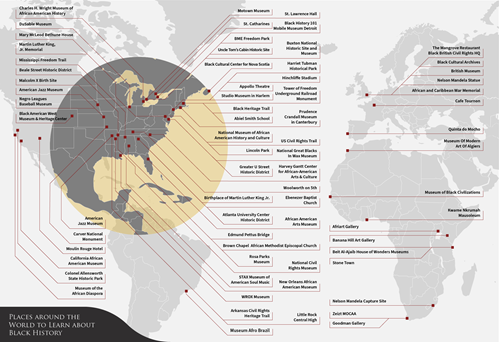70 Best Places Around the World to Celebrate and Learn About Black History & Culture
In recent months the importance of recognising Black history and culture has been the forefront of discussion more than ever, and a growing number of people have been taking active steps to educate themselves further on Black history.
With this in mind, we thought it would be useful to compile a list of some of the best places around the world to learn more about Black history and celebrate Black culture. From museums to entertainment venues; monuments; parks, and walking trails we’ve looked around the globe to compile a comprehensive guide to 70 of the best places around the world you can visit to discover more about Black history and celebrate Black culture.
AFRICA
Museum of Modern Art of Algiers, Algiers, Algeria
The Museum of Modern Art of Algiers is a modern art museum located in Algeria’s capital city. The museum curates a selection of modern art pieces by creatives from Algeria, curated by art historian Mohamed Djehiche. The museum was inaugurated in 2007 as part of the Algiers, capital of the Arabic culture 2007 celebrations.
Kwame Nkrumah Mausoleum, Accra, Ghana
The Kwame Nkrumah Mausoleum and memorial park is a dedication to the former Ghanaian President Kwame Nikrumah. He was the first Prime Minister and President of Ghana after leading the Gold Coast to independence from Britain in 1957. The Mausoleum houses the body of both Nikrumah and his wife Fathia.
Banana Hill Art Gallery, Nairobi, Kenya
The Banana Hill Art Gallery in Nairobi has a clear mission - create exposure for African artists and promote art appreciation in the area. The museum houses incredible artwork from local artists throughout Kenya. The gallery was opened in 2006 and has become a leading exhibition space for local artists, presenting exhibitions every two weeks, which relate to African culture and landscapes.
Museum of Black Civilizations, Dakar, Senegal
The Museum of Black Civilizations is a relatively new addition to Dakar, having opened its doors in 2018. The museum’s director is a respected archaeologist and researcher from the University Cheikh-Anta-Diop. The museum focuses on the contributions of Black culture around the world, and has been claimed as an important asset in helping Africa to reclaim artefacts which were plundered from the country during the colonial period.
Zeitz Mocaa, Cape Town, South Africa
Zeitz Mocaa is one of the most celebrated art galleries in all of Africa. The art museum is the largest museum of contemporary African art in the world. Surprisingly, the museum has only been open since 2017. The gallery is a not-for-profit establishment and houses work from prominent artists, including Chris Ofili, Kudzanai Chiurai, Kehinde Wiley, Glenn Ligon, Marlene Dumas, Wangechi Mutu and Julie Mehretu.
Goodman Gallery, Cape Town & Johannesburg, South Africa
The Goodman Gallery has not one but two venues in South Africa, one in Cape Town and one in Johannesburg. The gallery was first founded in Johannesburg in 1966. The galleries have a key focus on showcasing art which confronts entrenched power structures and inspires social change. The gallery works with both prominent and emerging artists, including Ghada Amer, El Anatsui, Candice Breitz, and Alfredo Jaar.
Nelson Mandela Capture Site, KwaZulu-Natal, South Africa
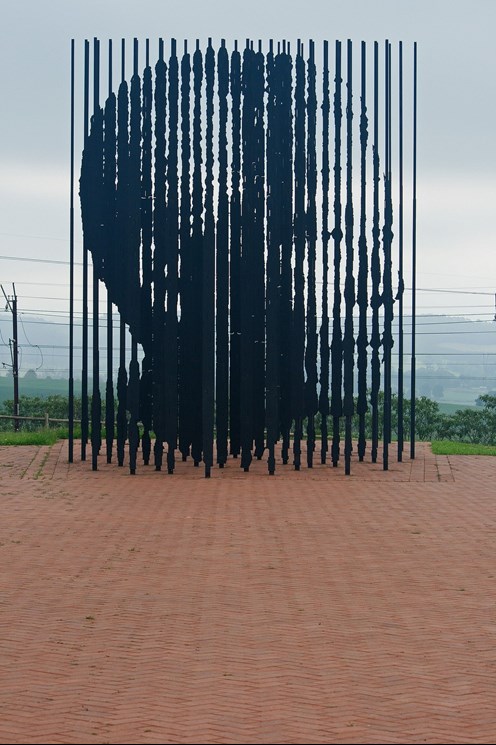
One of the most important landmarks in Black history is the Nelson Mandela Capture Site which can be found in the KwaZulu-Natal area of South Africa. The site where Mandela was arrested is marked by a mesmerising sculpture showcasing the face of the renowned activist.
Afriart Gallery, Kampala, Uganda
This small gallery in Kampala features work by talented local artists. The two-storey gallery features a permanent collection of works on the top level and changing monthly exhibits on the bottom level. Even better, everything in the gallery is for sale.
Stone Town, Zanzibar City, Zanzibar
Stone Town is the oldest part of Zanzibar City. This area of Zanzibar gives a key glimpse into the history of Zanzibar and East Africa, and has been dedicated as a UNESCO World Heritage Site. The architecture of Stone Town dates back to the 19th-century encompassing a unique mix of Arab, Persian, Indian and European influences. Stone Town was at one time the capital of Zanzibar as well as being the centre of the spice trade and the slave trade, both of which play a crucial role in the country’s history.
Beit al-Ajaib; The House of Wonders Museum, Zanzibar City, Zanzibar
The House of Wonders, also known as the Palace of Wonders, is located in Zanzibar’s Stone Town. The palace was built in the 1800s for the Second Sultan of Zanzibar. The building was a feat of its time, being the first building in Zanzibar to have electricity and the first in East Africa to have an elevator. The palace now houses the Museum of History and Culture of Zanzibar and the Swahili Coast, showcasing an array of unique objects and artefacts from the area.
NORTH AMERICA
BME Freedom Park, Chatham-Kent, Canada
The BME Freedom Park is located in the site of the first BME (British Methodist Episcopal) church in Canada. The Chatham BME church was established in 1856. The church played host to important meetings and moments, including the fight to end segregation in local schools being led by a minister from the church. The church fell into disrepair in 1989 but in 2009 the BME Freedom Park was established in its place, with a statue of Mary Ann Shadd Cary at its core. Cary was a feminist, activist and educator who was a resident of Chatham in the 1800s.
Buxton National Historic Site and Museum, Chatham-Kent, Canada
The Buxton National Historic Site and Museum is a tribute to the Elgin Settlement of Chatham-Kent. The Elgin Settlement was established by Rev. William King and Lord Elgin in 1849, providing a safe haven and new lives for freed Black slaves who had escaped to Canada. Rev. King was once a slave-owner himself but turned abolitionist and purchased 9,000 acres of land to create a safe settlement for former slaves in the area. For many the settlement was the final stop on the underground railway which helped US slaves escape to Canada.
Uncle Tom’s Cabin Historic Site, Chatham-Kent, Canada
Uncle Tom’s Cabin is a museum which is built on the site of another Canadian settlement. The Dawn Settlement was established by former slave Josiah Henson. The settlement was founded in 1841 and the site now hosts an open air museum with exhibits including Henson’s house, the Underground Railroad Freedom Gallery telling the story of how slaves escapes from the US to Canada on the Underground Railway, and Harris House - one of the oldest houses of the settlement.
Black Cultural Center for Nova Scotia, Cherrybrook, Canada
This museum and library source focuses on the history and culture of African Nova Scotians. The center hosts regular events as well as featuring a permanent exhibition about the former Nova Scotia community of Africville. The center opened its doors in 1983, setting out with the mission to educate and inspire, while protecting, preserving and promoting Black culture in Nova Scotia.
St. Catharines, Canada
The town of St. Catharines in Canada is a great place to visit to honour the life of Harriet Tubman. Tubman is often fondly referred to as ‘Black Moses’ - she was an escaped slave who dedicated her life to helping save others. Tubman was born into slavery but escaped in her late 20s. Tubman then carried out approximately 13 rescue missions to free others from slavery, saving around 70 people including her own family. In St Catharines there are many dedications to Harriet, including a plaque at the Salem Chapel across from where she lived and a school named after her which features a statue of her likeness.
St. Lawrence Hall, Toronto, Canada
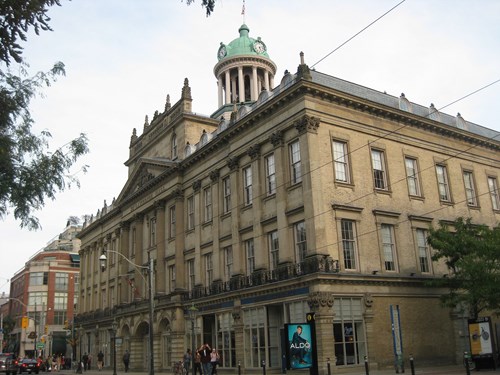
St. Lawrence Hall is a meeting hall in Toronto, and one of the most important meetings ever held here was the ‘North American Convention of Colored Freemen’. This meeting was a turning point in the end of slavery around the world, as abolitionist leaders from Canada, the U.S. and Britain gathered to discuss how to end slavery, and cemented Canada as a safe country for refuge.
Tower of Freedom Underground Railroad Monument, Windsor, Canada
The Underground Railroad is a key part of Canadian Black history, and the Tower of Freedom Underground Railroad Monument in Windsor commemorates this important movement. The monument pays tribute to all of the Black slaves who escaped to Canada from the USA using the underground railway. The Tower of Freedom depicts the freed slaves’ arrival into Canada and the emotion of freedom in that moment. The monument features the names of local people and important places to the Underground Railroad movement, alongside a bronze Canadian flag and the flame of freedom.
US Civil Rights Trail, USA
The US Civil Rights Trail spans over 100 locations across 15 different states, and is the most comprehensive way to learn about the US civil rights movement. Included on the incredible trail is the Martin Luther King National Historic Park, the Elizabeth Harden Gilmore House, the Hayti Heritage House and so much more. The Civil Rights Trail website offers a map of all sites included on the trail.
Atlanta University Center Historic District, Atlanta, USA
Atlanta university boasts incredible alumni who played a crucial role in shaping Black history and culture in the US, including Dr. Martin Luther King Jr., singer Mattiwilda Dobbs, filmmaker Spike Lee and politician Maynard H. Jackson Jr. Walk in the footsteps of these iconic Black figures on the grounds of the university.
Birthplace of Martin Luther King Jr., Atlanta, USA
Martin Luther King Jr. is one of the most prominent people in the history of civil rights in the US, and a visit to his birthplace is a truly special experience. The house where King was born in 1929, and where he lived until the age of 12, has been restored to the appearance of how it would have looked while King lived there. Wandering the rooms, it’s incredible to believe the difference the young boy growing up in this house would make to the world.
Ebenezer Baptist Church, Atlanta, USA
The Ebenezer Baptist Church is another important landmark in exploring the life of Martin Luther King Jr. in his home of Atlanta. King was an assistant pastor of the church from 1927, going on to become co-pastor of the church along with his father from 1960 until 1968. The historic church was first founded in 1886.
Harriet Tubman Historical Park, Auburn NY, USA
Another location to celebrate the life of Harriet Tubman is the Harriet Tubman Historical Park in Auburn, New York state. The park includes the HarrietTubman Home for the Aged, in Auburn; the Harriet Tubman Residence, and the Thompson A.M.E. Zion Church in Auburn. The Harriet Tubman Home for the Aged was opened by Tubman as a home to care for elderly African-Americans and is where she herself stayed from 1911 to her passing in 1913. The Harriet Tubman Residence was Tubman’s home for much of her time living in Auburn, and the church is where she attended services.
National Great Blacks in Wax Museum, Baltimore, USA
This wax museum based in Baltimore features waxworks of prominent African Americans and Black people from around the world throughout history. Some of the figures included in the museum are Martin Luther King Jr., Harriet Tubman, Barack Obama, Bob Marley, Rosa Parks and Nelson Mandela.
Abiel Smith School, Boston, USA
The Abiel Smith School was the first ever public school in the US for African-Americans. The school was founded in 1835 and was funded by a donation left in his will by philanthropist Abiel Smith. The school has been deemed a National Historic Landmark and is part of the Boston African American National Historic Site.
Black Heritage Trail, Boston, USA
The Abiel Smith School is just one stop on Boston’s Black Heritage Trail. The full trail takes in an array of landmarks commemorating and celebrating Black history and culture in the city. Stops on the trail include the oldest surviving Black church in the USA, and Hayden House - one of the most famed stops on the Underground Railroad.
Prudence Crandall Museum in Canterbury, Canterbury, USA
The Prudence Crandall Museum was the site of the Prudence Crandall Female Boarding School. Originally opened from 1831 to 1833 for white students, the admittance of a Black student caused many white parents to withdraw their daughters from the school. In 1833 Crandall re-opened the school catering exclusively for Black students. Sadly, the school closed after one year due to extreme public outcry and violence, but Crandall remains a celebrated heroine in Canterbury today for her efforts in bringing education to African American females.
Harvey B. Gantt Center for African-American Arts & Culture, Charlotte, USA
The Harvey B. Gannt center is named after Charlotte’s first African American mayor. The centre is a celebration of African American culture, arts and entertainment displaying visual arts and hosting music, dance and theatre events and classes.
DuSable Museum, Chicago, USA
The DuSable Museum is the first and oldest museum about African-American history and culture, having been founded in 1961 by Margaret Taylor-Burroughs. The museum was set up to celebrate Black culture, which at the time was largely ignored by other museums and academics. The museum continually expands and adapts with the times to give a relevant and current insight into Black culture.
WROX Museum, Clarksdale,USA
This unique museum is located in the studio where the WROX radio station was broadcast from. The specialist radio station catered specifically for an African-American audience and was hosted by the famous radio personality Early Wright. The station aired between 1945 and 1955 and notable blues artists including Ike Turner and Raymond Hill are just some of the names who performed on-air here.
African American Arts Museum, DeLand, USA
The African American Arts Museum in DeLand, Florida, encompasses a museum, art gallery and performance space. The venue was established in 1994, and features a permanent collection of more than 150 artefacts as well as a revolving roster of new and emerging artists. The theatre space provides performing arts workshops for the local community.
Black American West Museum & Heritage Center, Denver, USA
This museum offers a unique insight into the lives of Black Americans in the Wild West. According to stats from the museum 1 in 3 Colorado cowboys were African American. The small museum looks at the contribution of African Americans during the pioneering era, and aims to provide an understanding of the roles which Black Americans played in the settlement and growth of the Western United States.
Black History 101 Mobile Museum, Detroit, USA
This 101 museum covers all aspects of Black history you could want to learn more about, from the history of slavery to the modern day music scene. The museum hosts an award-winning collection of over 7,000 artefacts of Black memorabilia. The travelling museum originates in Detroit but takes its exhibits on the road, having visited 40 states.
Charles H. Wright Museum of African American History, Detroit, USA
The Charles H. Wright Museum of African American History is home to the world’s largest permanent exhibit on African-American history and culture. Some key inclusions in their permanent exhibits include the Blanche Coggin Underground Railroad Collection, the Harriet Tubman Museum Collection, and the Sheffield Collection. The museum also hosts temporary exhibitions, hundreds of events each year and education and research opportunities for adults and children alike.
Motown Museum, Detroit, USA
The best place to celebrate and learn more about the magnificent music of motown. Step inside original studio and headquarters where the “Motown Sound” was born. The museum has been restored to its 1960s appearance so visitors can fully appreciate the location where acts such as the Supremes, Temptations, Martha Reeves & The Vandellas, Marvin Gaye, Four Tops, Smokey Robinson & The Miracles, Gladys Knight & The Pips Stevie Wonder, and The Jackson 5 recorded their first hits.
Colonel Allensworth State Historic Park, Earlimart, USA
Colonel Allensworth was one of the four founding members of California’s first, and only, town to be founded, financed and governed by African Americans. Allensworth was founded in 1908, and the State Historic Park preserves this important Californian settlement. The site comprises nine restored buildings, including a schoolhouse, a hotel, a general store, a library and several houses.
American Jazz Museum, Kansas City, USA
A must-visit for jazz lovers, the American Jazz Museum is a complete celebration of jazz music in the US and the important role which African Americans played in developing this genre. The museum is located in the historic 18th and Vine District of Kansas City which is internationally esteemed as a core area in the origin of jazz music. The museum features exhibits on legendary jazz artists, as well as housing its very own jazz club The Blue Room which hosts live performances every week.
Negro Leagues Baseball Museum, Kansas City, USA
Sharing a building with the American Jazz Museum is the Negro Leagues Baseball Museum. This museum is dedicated to preserving the history of negro league baseball in America. The museum was founded in 1990 by former players from the league. The building initially started as a small one-room affair and has since expanded twice. The museum spans exhibits from the 1920s Negro National League through to the Negro American League which was in play until 1962.
Moulin Rouge Hotel, Las Vegas, USA
Not in Paris, the Moulin Rouge Hotel is in Las Vegas but of course it takes its namesake from the French club. The hotel was incredibly novel as the first integrated hotel in the city, and played host to many of the Black performers who performed across the city’s clubs and casinos. The hotel and casino was built in 1955 and sadly had a short lifespan filing for bankruptcy within the same year but it no doubt was the first step in integrating the iconic Vegas strip. The remnants of the hotel are available to visit.
Arkansas Civil Rights Heritage Trail, Little Rock, USA
The Arkansas Civil Rights Heritage Trail is a trail honouring the people and places across Little Rock which were important in the civil rights movement. The trail is made up of plaques and memorial honouring key people and places. New markers are added to the trail in a public ceremony every year.
Little Rock Central High, Little Rock, USA
Little Rock Central High in Arkansas was the first ever school in the USA to desegregate. The school became desegregated in 1957, following the ruling three years earlier that segregated schools were unconstitutional. This was a pivotal moment in the civil rights movement and at the peak of the action being taken. The movement at the time was not entirely positive having being introduced off the back of nine students (The Little Rock Nine) being initially denied entry to school and facing extreme opposition from the community when they integrated. However, now the school celebrates and honours the part it played in the integration of schools in the US.
California African American Museum, Los Angeles, USA
This museum has been billed as the first African-American museum of art, history, and culture fully supported by a state. The museum focuses on enrichment and education about African America cultural heritage and history, with a particular emphasis on California and other parts of the western United States. It is located in the Exposition Park and is free for all visitors.
Beale Street Historic District, Memphis, USA
Beale Street is a must-visit in Memphis, home to the legendary BB King’s Blues Club, and widely regarded as the location where some of the best early jazz, blues, and R&B music began. The street in downtown Memphis runs a distance of 1.8 miles and is lined with bars and restaurants honouring the city’s blues connections.
National Civil Rights Museum, Memphis, USA
The National Civil Rights Museum is located at the site of Martin Luther King Jr.’s assassination, and has since been developed into a civil rights museum. The museum is spread over a number of buildings and traces the history of US civil rights from back in the 17th-century though to the present day.
STAX Museum of American Soul Music, Memphis, USA
Another one for music lovers, the STAX Museum is located in the original site of Stax Records paying tribute to all of the artists who recorded there. The museum features over 2,000 interactive exhibits, films, artefacts, items of memorabilia and galleries. A highlight of the museum is definitely the reconstruction of its recording studio allowing you to really step back in time to this classic moment in music history.
Mississippi Freedom Trail, Mississippi, USA
The Mississippi Freedom Trail spans the entire state of Mississippi. The trail was created in 2011 to commemorate the people and places across the state which played a pivotal role in the civil rights movement. The trail has placed a series of markers throughout the state commemorating these people and places including Fannie Lou Hamer, William Chapel and Unita Blackwell.
Rosa Parks Museum, Montgomery, USA
Rosa Parks played a key role in the civil rights movement on the day she refused to give up her seat on the bus for a white person. This was in 1955 at time when buses were segregated with white and Black sections. Parks’ action led to a boycott of the bus company, a movement which was pivotal in the fight for civil rights. The Rosa Parks museum presents comprehensive information, exhibits and artefacts about the boycott.
National Museum of African American Music, Nashville, USA
One you will have to wait a little longer to visit. Nashville is the home of country music, but this museum will focus specifically on African American music and its impact on global culture. The museum is set to open in Nashville in 2020. The museum will host five permanent collections alongside changing exhibits and a 2,000 seat theatre. Artefacts set to be included in the museum are clothes worn by Nat King Cole, Whitney Houston and Lisa Lopes.
Woolworth on 5th, Nashville, USA
This Nashville restaurant gained notoriety as the site of the 1960s lunch counter sit-ins, which gathered momentum in the city. During these sit-ins, smartly dressed students gathered in diners to silently protest against segregation. The original site has been restored with a reimagined eatery playing honour to the original counter sit-ins and incorporating that history into its decor and menu.
New Orleans African American Museum, New Orleans, USA
The New Orleans African American Museum is located in the oldest surviving Black community in the world, the historic Tremé neighbourhood. The museum is committed to protecting, preserving and promoting the history, art and communities of African American New Orleans and the African Diaspora through educating visitors. The museum is located on the site of a former plantation. One of the museum's main exhibitions is the Louisiana-Congo: the Bertrand Donation, which features a range of African beadwork, costumes, masks, textiles and musical instruments. The aim of this exhibit is to highlight the parallels between everyday life in the Congo and Louisiana folk culture.
Apollo Theatre, New York City, USA
This theatre located in the Harlem area of NYC is an incredible celebration of African American talent. Artists who have performed at the iconic theatre include Billie Holiday, James Brown and Ella Fitzgerald. Today the theatre is a not-for-profit presenting concerts, performing arts, education and community outreach programs.
Studio Museum in Harlem, New York City, USA
The Studio Museum in Harlem is all about celebrating creativity across the arts among African American creatives. The museum was founded in 1968 by a group of artists, community activists and philanthropists, and has become a hub for local, national and international artists of African descent and work inspired by African and Black culture.
Carver National Monument, Newton County, USA
The Carver National Monument was the first national monument dedicated to an African American, as well as being the first public monument for a non-president. The monument was founded by Franklin Roosevelt who donated $30,000 to the structure’s creation. The monument commemorates George Washington Carver who was the most prominent Black scientist of the early 20th century with his work focused on alternative crops to cotton and promoting environmentalism.
Malcolm X Birth Site, Omaha, USA
Malcolm X is one of the most prominent civil rights activists and spokespersons of all time. The minister was born in Omaha and did not have the easiest childhood after the death of his father and hospitalisation of his mother. The original house which Malcolm lived in with his family was torn down by the new owners, but upon discovering its connection to the activist they led the efforts to have the house recognised as a historic site. Today the site is now owned by the Malcolm X Foundation.
Hinchliffe Stadium, Paterson, USA
From 1933 to 1937, and again between 1933 and 1937, the Hinchcliffe Stadium was the home field for the New York Black Yankees. The Hinchliffe is one of the few surviving stadiums for Black athletes during the segregation era. There are currently talks in place to restore the stadium to its former glory and use it once more as a sporting venue.
Museum of the African Diaspora, San Francisco, USA
The museum located in San Francisco, focuses on the movement of Africans around the world from the earliest times through to current days. The museum looks at how African art, culture and history has spread and influenced around the world. The museum is housed in a fantastic location within the 42-story skyscraper St. Regis Museum Tower.
Brown Chapel African Methodist Episcopal Church, Selma, USA
The chapel was the starting point for the Selma to Montgomery voting rights marches in 1965, and was also the meeting place and offices forthe Southern Christian Leadership Conference (SCLC) during the Selma Movement. This movement and the ‘Bloody Sunday’ March played a key role in the passing of the Voting Rights Act of 1965.
Edmund Pettus Bridge, Selma, USA
The Edmund Pettus Bridge runs over the Alabama River in Selma. The bridge was built in 1940. The bridge was the site of the Bloody Sunday protest march for African American voting rights. There has been calls to rename the bridge the Bloody Sunday Bridge in recognition of the march, and to remove association with Edmund Pettus who the bridge is named after. The curved edges of the bridge have come to symbolise the spirit of the civil rights’ activists who marched on the bridge.
Greater U Street Historic District, Washington DC, USA
This historic district was the center of Washington’s African American community between c.1900 and 1948. The district was a hub of African American owned and operated businesses, entertainment facilities, and fraternal and religious institutions. The area is often referred to as a ‘city within a city’. Wandering the area now provides a fascinating look at Victorian-era architecture.
Lincoln Park, Washington DC, USA
Lincoln Park features the Mary McLeod Bethune memorial, which is the first monument to honour a Black woman in a public park. Mary Jane McLeod was an educator, stateswoman, philanthropist, humanitarian, womanist, and civil rights activist. She founded the National Council for Negro Women in 1935 and was a leader for a number of other Africa American women’s groups.
Martin Luther King Jr. Memorial, Washington DC, USA
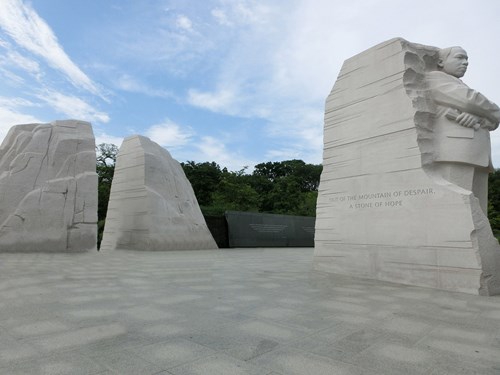
Washington DC is home to many incredible monuments of historic figures around the National Mall, and included here is the Martin Luther King Jr. Memorial. The official address of the memorial is 1964 Independence Avenue SW, which is a nod to the Civil Rights Act of 1964, a landmark legislation in which King played an important role. The centrepiece of the memorial is a 30-foot statue of Martin Luther King Jr. The centrepiece focuses on quotes from his ‘I Have a Dream’ speech while the monument is also surrounded by quotes from his many other iconic and inspirational speeches.
Mary McLeod Bethune House, Washington DC, USA
The Mary McLeod Bethune House honours the life and home of Mary McLeod Bethune. Historically, the Bethune House was a site for discussions, activism and programs to support African American women, with Bethune living on the ground floor of the home and the top two floors being the base for the National Council of Negro Women. The house offers tours each day, with exhibits and an audio recording of Bethune’s last speech.
SOUTH AMERICA
Museu Afro Brasil, Sao Paulo, Brazil
The Museo Afro Brasil is an art, history and ethnography museum focused on the history and lives of Black people in Brazil through the research, preservation and exhibition of artefacts and works relating to the cultural sphere of Black people in Brazil. The museum holds around 6,000 items including paintings, sculptures, photographs, archives, documents and more.
EUROPE
Café Tournon, Paris, France
This Parisian café became a centrefold of Black history and culture as it played host to a salon for African-America writers and other creatives for decades. Notable figures for whom the traditional café was a regular hangout include novelist Richard Wright, painter Beauford Delaney, writer Chester Himes and jazz performer Duke Ellington.
Quinta do Mocho, Sacavém, Portugal
Quinta do Mocho is a neighbourhood in Portugal, just on the outskirts of Lisbon which is primarily home to people of African descent. The area has traditionally been known as one of the poorest estates of Lisbon and its surroundings, having been built as a social housing project in the 1990s. But now, the area is gaining notoriety as the city’s ‘open air gallery’ thanks to the incredible street art on display throughout the neighbourhood. Buildings and walls throughout Quinta do Mocho are embellished with large and incredibly skilled portraits and artworks, depicting the lives of the people in the area, their backgrounds and ancestors.
African and Caribbean War Memorial, London, UK
Located in Brixton, the African and Caribbean War Memorial is dedicated to the African and Caribbean service personnel who fought for Britain in the first and second world wars. The memorial has been in place since 2017, and is the only memorial specifically dedicated to the over 2 million Caribbean and African service men and women who represented Britain in both world wars.
Black Cultural Archives, London, UK
The Black Cultural Archives in London is dedicated to preserving and celebrating the lives of African and Caribbean people in Britain. It is the only centre of its kind in Britain. The centre hosts numerous events and exhibitions throughout the year, ranging from exhibitions focusing specifically on Black women, exhibitions looking at specific time periods, such as the Georgians and exhibitions focused on particular historic figures. The archives first opened in 1981 but have been in their current building since 2014 - the building was named ‘building of the year’ in 2015.
British Museum, London, UK
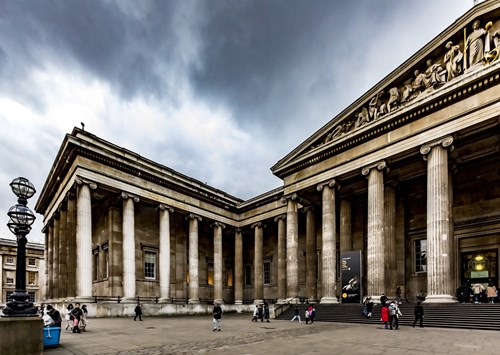
The British Museum is of course one of the most popular visitor attractions in London, and the Africa section specifically is a fascinating place to learn more about African history. The Africa Galleries is a highlight of the department, permanently displaying African art from ancient history through to the present day. As well as providing a glimpse of the incredible artwork, the galleries focus on topics ranging from identity to gender, power, religion and more. Across the wider Africa section of the museum visitors can find historical artefacts and contemporary objects - including silks from Ghana, brass plaques from Benin and Palaeolithic stone tools from Tanzania. The museum works closely with African colleagues in curating their collection and focusing their strategy.
Nelson Mandela Statue, London, UK
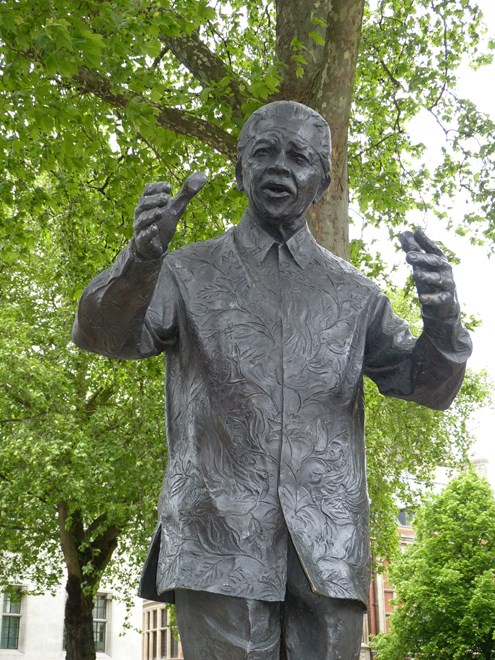
The Nelson Mandela Statue stands proudly in Parliament Square, London. It may be surprising to learn that the statue was only built in 2007. The bronze masterpiece which celebrates the former President of South Africa, was part of a fundraising effort spearheaded by Lord Richard Attenborough to honour the idea first proposed by the late South African journalist Donald Woods. The statue was unveiled on 29th August 2007.
The Mangrove Restaurant: Black British Civil Rights HQ, London, UK
The Mangrove Restaurant was a Caribbean restaurant in Notting Hill opened in 1968 by Trinidian community activist Frank Crichlow. The restaurant was a popular meeting spot for the Black community, but the venue soon became a target of police attention with what appeared to be an effort to shut down the popular meeting place. The police raid led to a protest by the community, telling police “hands of the Mangrove.” The protest ended with the arrest of nine of the protesters, often referred to as the Mangrove Nine. The highly anticipated trial saw all charges dropped against 5 of the nine, and the others charged on lesser grounds. The protest and trial attracted major attention to the issue of Black relations with police at the time and was a pivotal moment in Black British history. While the restaurant is no longer open to sit in, a visit to the site where it once stood offers the chance to reflect on the dramatic events which unfolded here.

